2008 CHRYSLER TOWN AND COUNTRY low oil pressure
[x] Cancel search: low oil pressurePage 96 of 531

PERIODIC SAFETY CHECKS YOU SHOULD MAKE
OUTSIDE THE VEHICLE
Tires
Examine tires for excessive tread wear or uneven wear
patterns. Check for stones, nails, glass, or other objects
lodged in the tread. Inspect tread and sidewall for cuts or
cracks. Check wheel nuts for tightness, and tires (includ-
ing spare) for proper pressure.
Lights
Have someone observe the operation of exterior lights
while you work the controls. Check turn signal and high
beam indicator lights on the instrument panel.
Fluid Leaks
Check area under vehicle after overnight parking for fuel,
engine coolant, oil or other fluid leaks. Also, if gasoline
fumes are detected or fuel, power steering fluid, trans-
mission fluid or brake fluid leaks are suspected, the cause
should be located and corrected immediately.
Exhaust Gas
WARNING!
Exhaust gases can injure or kill. They contain carbon
monoxide (CO) which is colorless and odorless.
Breathing it can make you unconscious and can
eventually poison you. To avoid breathing (CO)
follow the safety tips below.
Do not run the engine in a closed garage or in confined
areas any longer than needed to move your vehicle in or
out of the area.
If it is necessary to sit in a parked vehicle with the engine
running, adjust your heating or cooling controls to force
outside air into the vehicle. Set the blower at high speed.
94 THINGS TO KNOW BEFORE STARTING YOUR VEHICLE
Page 231 of 531
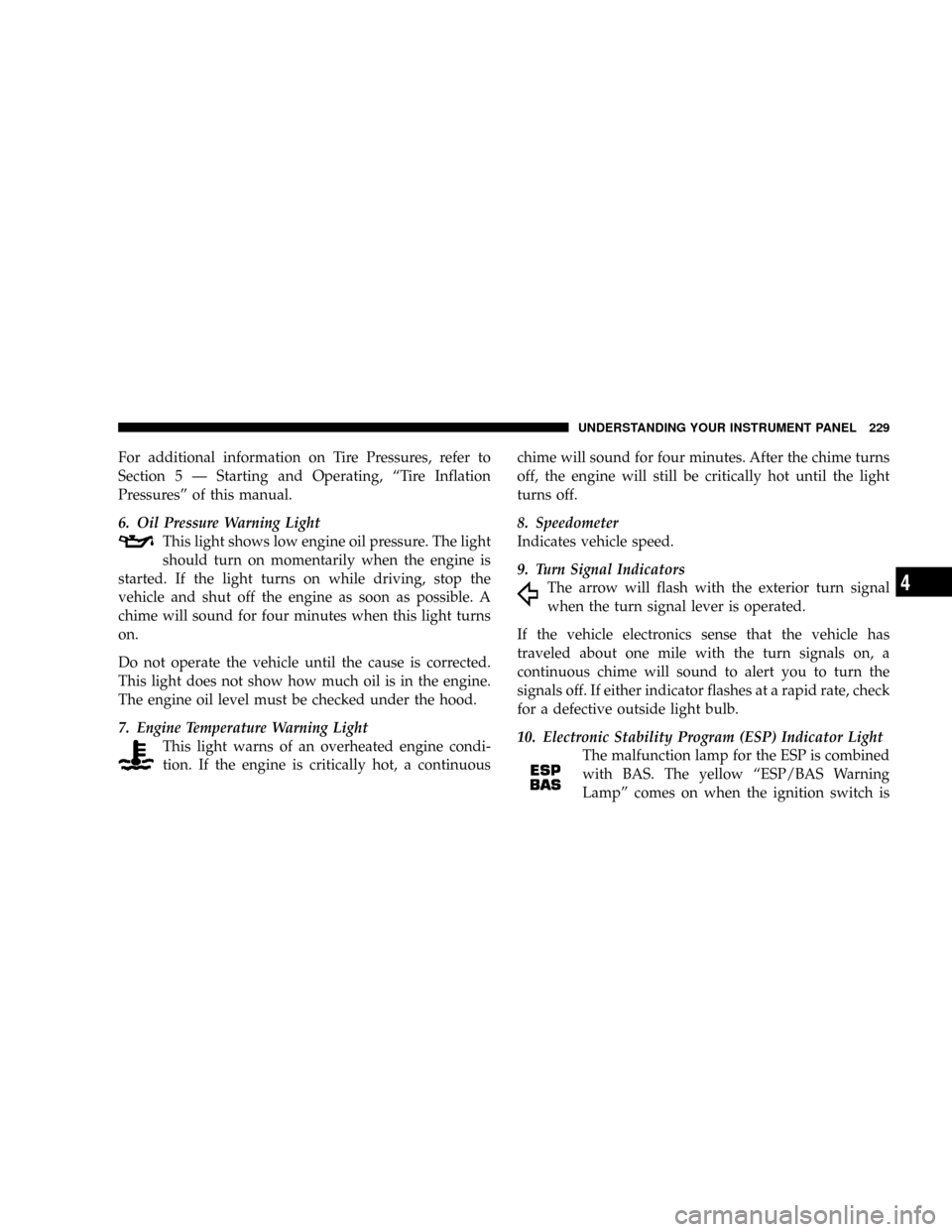
For additional information on Tire Pressures, refer to
Section 5 Ð Starting and Operating, ªTire Inflation
Pressuresº of this manual.
6. Oil Pressure Warning Light
This light shows low engine oil pressure. The light
should turn on momentarily when the engine is
started. If the light turns on while driving, stop the
vehicle and shut off the engine as soon as possible. A
chime will sound for four minutes when this light turns
on.
Do not operate the vehicle until the cause is corrected.
This light does not show how much oil is in the engine.
The engine oil level must be checked under the hood.
7. Engine Temperature Warning Light
This light warns of an overheated engine condi-
tion. If the engine is critically hot, a continuouschime will sound for four minutes. After the chime turns
off, the engine will still be critically hot until the light
turns off.
8. Speedometer
Indicates vehicle speed.
9. Turn Signal Indicators
The arrow will flash with the exterior turn signal
when the turn signal lever is operated.
If the vehicle electronics sense that the vehicle has
traveled about one mile with the turn signals on, a
continuous chime will sound to alert you to turn the
signals off. If either indicator flashes at a rapid rate, check
for a defective outside light bulb.
10. Electronic Stability Program (ESP) Indicator Light
The malfunction lamp for the ESP is combined
with BAS. The yellow ªESP/BAS Warning
Lampº comes on when the ignition switch is
UNDERSTANDING YOUR INSTRUMENT PANEL 229
4
Page 236 of 531
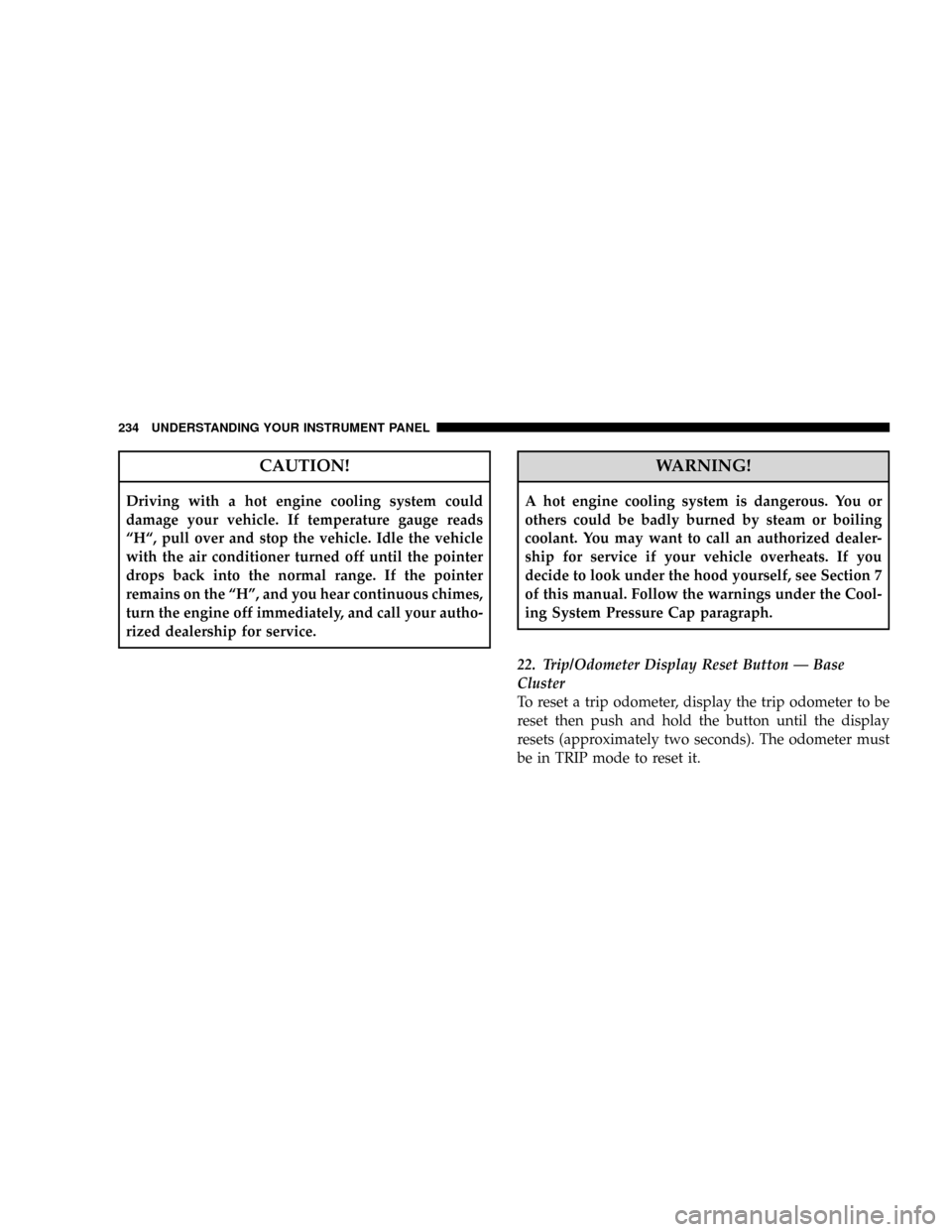
CAUTION!
Driving with a hot engine cooling system could
damage your vehicle. If temperature gauge reads
ªHª, pull over and stop the vehicle. Idle the vehicle
with the air conditioner turned off until the pointer
drops back into the normal range. If the pointer
remains on the ªHº, and you hear continuous chimes,
turn the engine off immediately, and call your autho-
rized dealership for service.
WARNING!
A hot engine cooling system is dangerous. You or
others could be badly burned by steam or boiling
coolant. You may want to call an authorized dealer-
ship for service if your vehicle overheats. If you
decide to look under the hood yourself, see Section 7
of this manual. Follow the warnings under the Cool-
ing System Pressure Cap paragraph.
22. Trip/Odometer Display Reset Button Ð Base
Cluster
To reset a trip odometer, display the trip odometer to be
reset then push and hold the button until the display
resets (approximately two seconds). The odometer must
be in TRIP mode to reset it.
234 UNDERSTANDING YOUR INSTRUMENT PANEL
Page 246 of 531

Press the STEP button to scroll through sub
menus (i.e. Trip Functions, Avg. Fuel Economy,
DTE, Elapsed Time, and Units.
Steering Wheel EVIC Compass/Temp
Control Button as it appears on the
right side of the steering column
Press and release the C/T button to for instant
access to the Compass/Temperature Screens.
Press this button to RESET Trip Functions and
Change Personal Settings.EVIC Displays
When the appropriate conditions exist, the EVIC displays
the following messages:
²Door(s) Ajar (with a single chime if vehicle is in
motion)
²Liftgate Ajar (chime will sound when vehicle starts
moving)
²Hood Ajar (If equipped with hood switch)
²Check TPM System. Refer to ªTire Pressure Monitor-
ing Systemº in Section 5 of this manual.
²Turn Signal On
²RKE Battery Low
²LOW WASHER FLUID
²Oil Change Required
²Left Front Turn Signal Light Out
244 UNDERSTANDING YOUR INSTRUMENT PANEL
Page 326 of 531
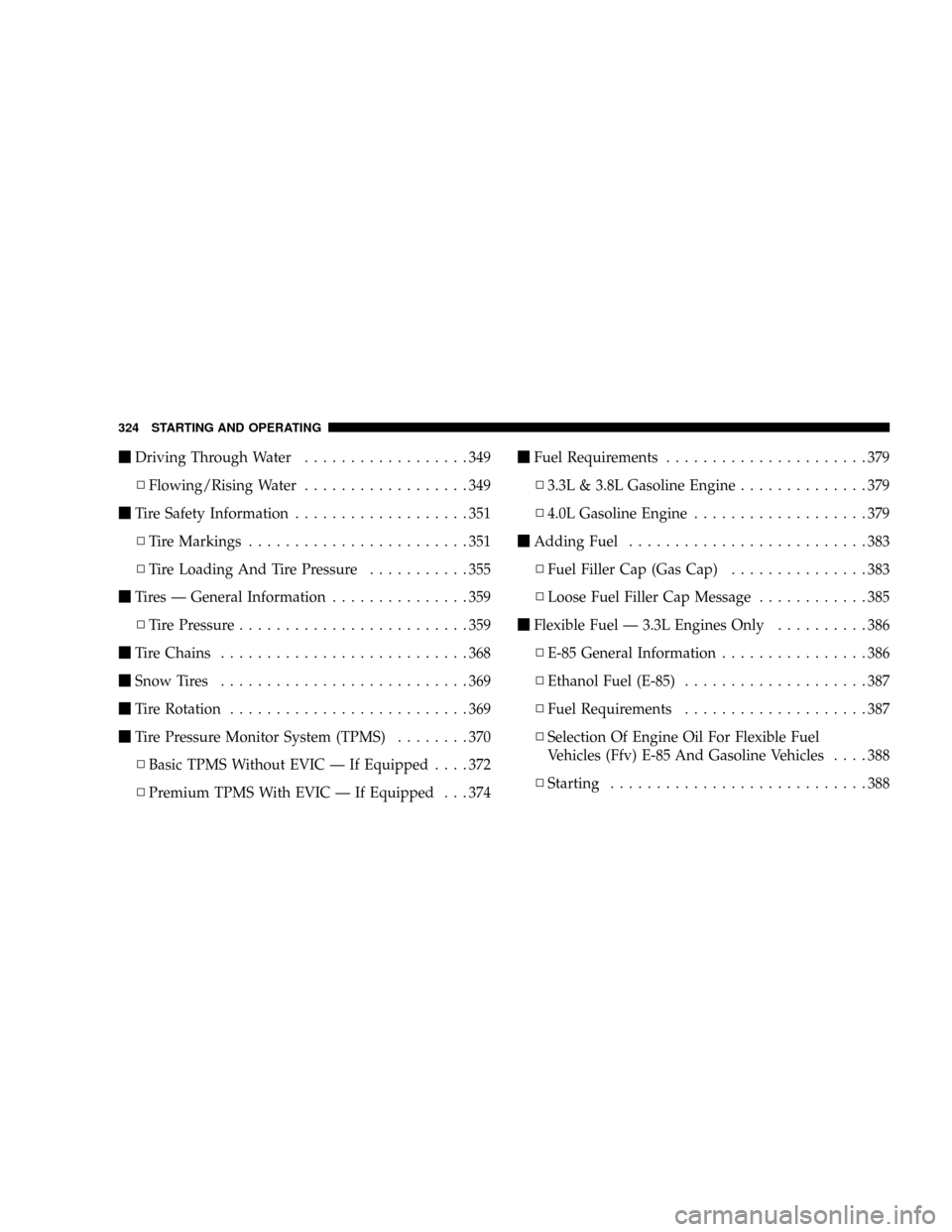
mDriving Through Water..................349
NFlowing/Rising Water..................349
mTire Safety Information...................351
NTire Markings........................351
NTire Loading And Tire Pressure...........355
mTires Ð General Information...............359
NTire Pressure.........................359
mTire Chains...........................368
mSnow Tires...........................369
mTire Rotation..........................369
mTire Pressure Monitor System (TPMS)........370
NBasic TPMS Without EVIC Ð If Equipped....372
NPremium TPMS With EVIC Ð If Equipped . . . 374mFuel Requirements......................379
N3.3L & 3.8L Gasoline Engine..............379
N4.0L Gasoline Engine...................379
mAdding Fuel..........................383
NFuel Filler Cap (Gas Cap)...............383
NLoose Fuel Filler Cap Message............385
mFlexible Fuel Ð 3.3L Engines Only..........386
NE-85 General Information................386
NEthanol Fuel (E-85)....................387
NFuel Requirements....................387
NSelection Of Engine Oil For Flexible Fuel
Vehicles (Ffv) E-85 And Gasoline Vehicles....388
NStarting............................388
324 STARTING AND OPERATING
Page 368 of 531
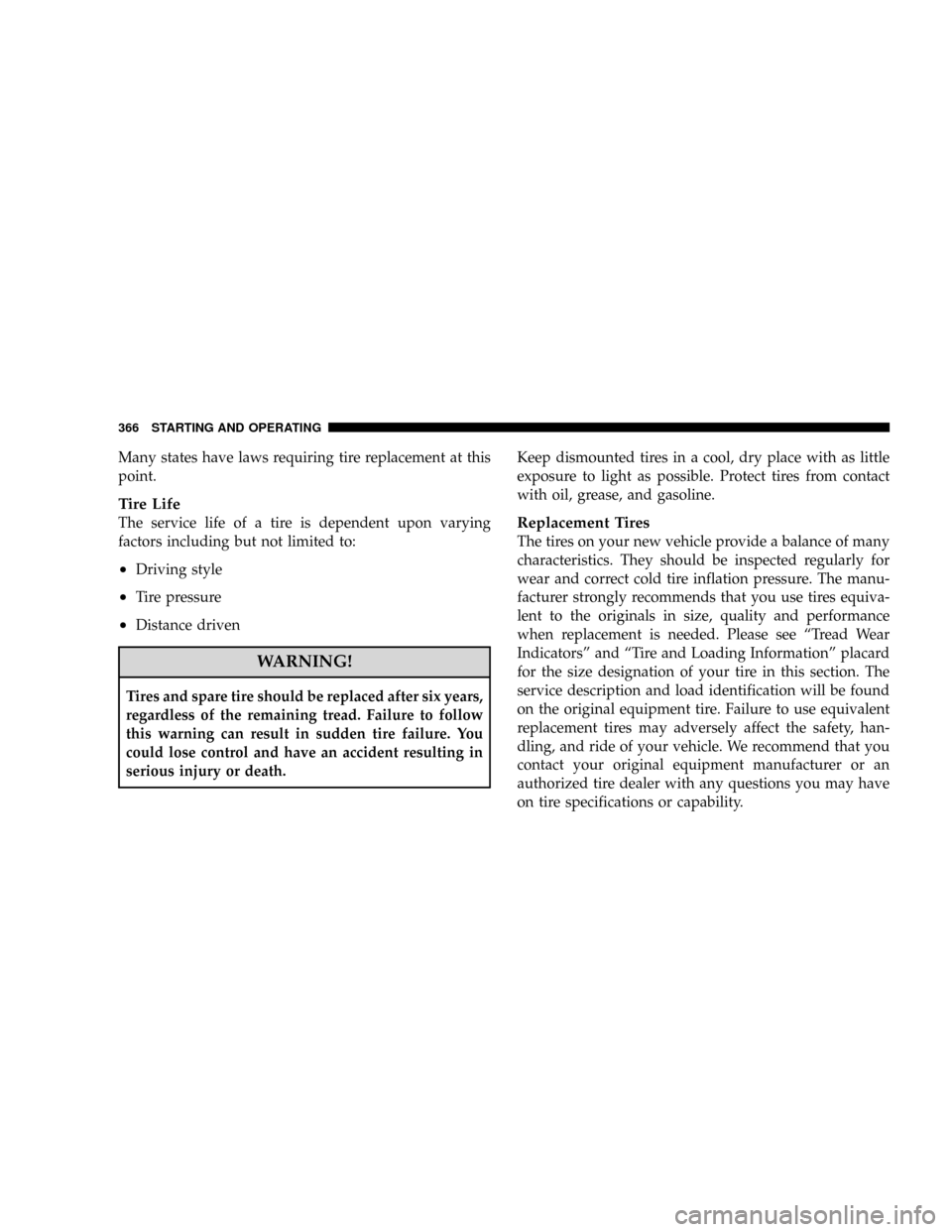
Many states have laws requiring tire replacement at this
point.
Tire Life
The service life of a tire is dependent upon varying
factors including but not limited to:
²Driving style
²Tire pressure
²Distance driven
WARNING!
Tires and spare tire should be replaced after six years,
regardless of the remaining tread. Failure to follow
this warning can result in sudden tire failure. You
could lose control and have an accident resulting in
serious injury or death.Keep dismounted tires in a cool, dry place with as little
exposure to light as possible. Protect tires from contact
with oil, grease, and gasoline.
Replacement Tires
The tires on your new vehicle provide a balance of many
characteristics. They should be inspected regularly for
wear and correct cold tire inflation pressure. The manu-
facturer strongly recommends that you use tires equiva-
lent to the originals in size, quality and performance
when replacement is needed. Please see ªTread Wear
Indicatorsº and ªTire and Loading Informationº placard
for the size designation of your tire in this section. The
service description and load identification will be found
on the original equipment tire. Failure to use equivalent
replacement tires may adversely affect the safety, han-
dling, and ride of your vehicle. We recommend that you
contact your original equipment manufacturer or an
authorized tire dealer with any questions you may have
on tire specifications or capability.
366 STARTING AND OPERATING
Page 413 of 531
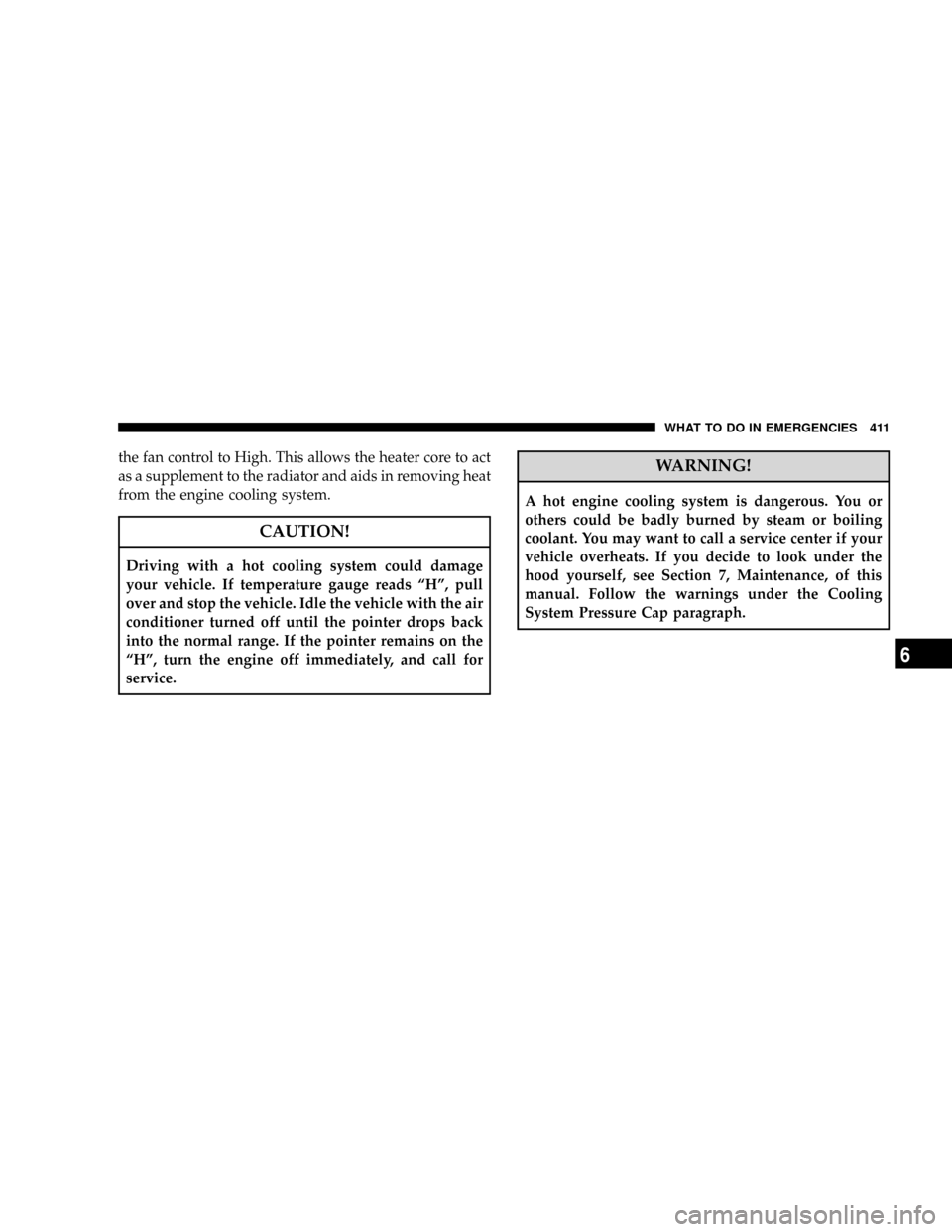
the fan control to High. This allows the heater core to act
as a supplement to the radiator and aids in removing heat
from the engine cooling system.
CAUTION!
Driving with a hot cooling system could damage
your vehicle. If temperature gauge reads ªHº, pull
over and stop the vehicle. Idle the vehicle with the air
conditioner turned off until the pointer drops back
into the normal range. If the pointer remains on the
ªHº, turn the engine off immediately, and call for
service.
WARNING!
A hot engine cooling system is dangerous. You or
others could be badly burned by steam or boiling
coolant. You may want to call a service center if your
vehicle overheats. If you decide to look under the
hood yourself, see Section 7, Maintenance, of this
manual. Follow the warnings under the Cooling
System Pressure Cap paragraph.
WHAT TO DO IN EMERGENCIES 411
6
Page 520 of 531
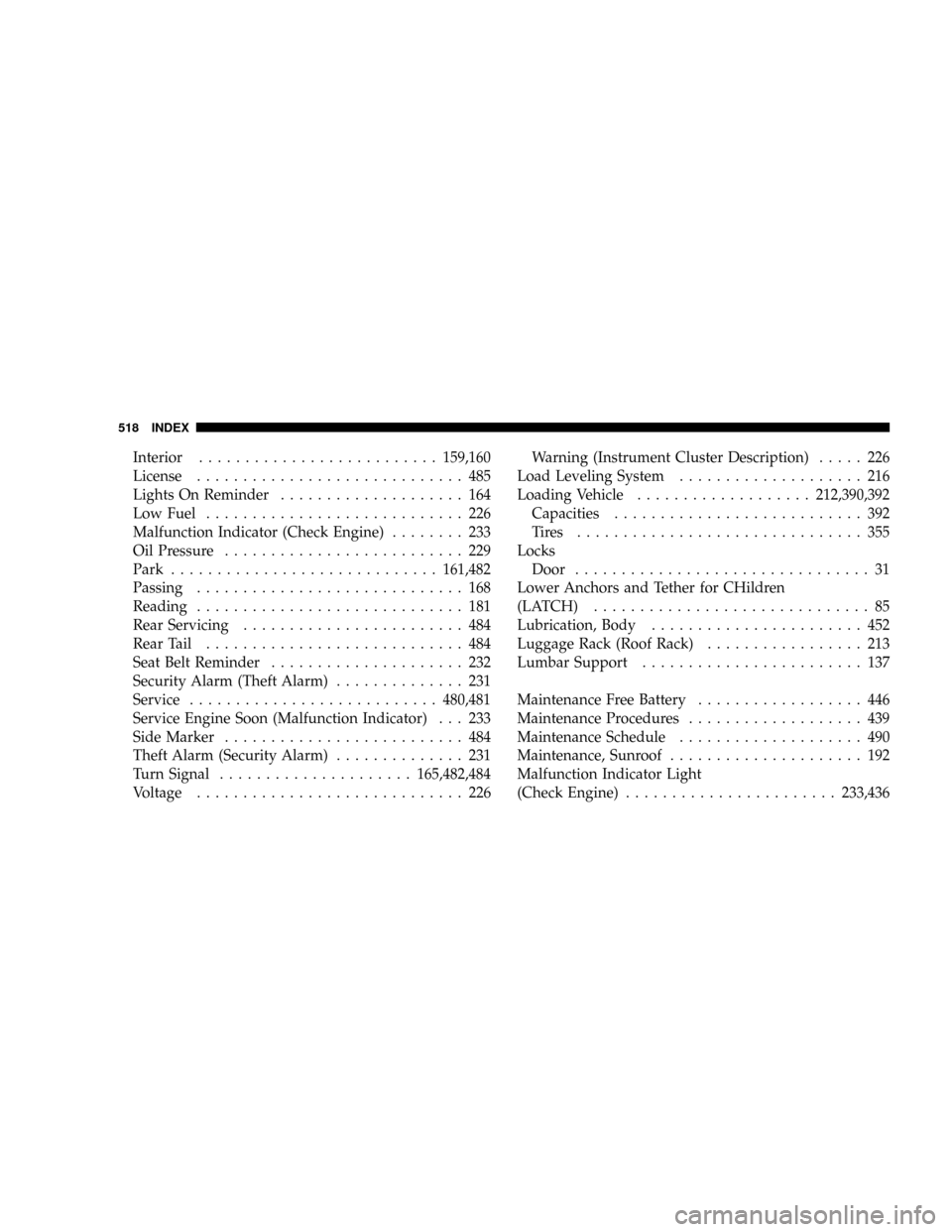
Interior..........................159,160
License............................. 485
Lights On Reminder.................... 164
Low Fuel............................ 226
Malfunction Indicator (Check Engine)........ 233
Oil Pressure.......................... 229
Park.............................161,482
Passing............................. 168
Reading............................. 181
Rear Servicing........................ 484
Rear Tail............................ 484
Seat Belt Reminder..................... 232
Security Alarm (Theft Alarm).............. 231
Service...........................480,481
Service Engine Soon (Malfunction Indicator) . . . 233
Side Marker.......................... 484
Theft Alarm (Security Alarm).............. 231
Turn Signal.....................165,482,484
Voltage............................. 226Warning (Instrument Cluster Description)..... 226
Load Leveling System.................... 216
Loading Vehicle...................212,390,392
Capacities........................... 392
Tires ............................... 355
Locks
Door................................ 31
Lower Anchors and Tether for CHildren
(LATCH).............................. 85
Lubrication, Body....................... 452
Luggage Rack (Roof Rack)................. 213
Lumbar Support........................ 137
Maintenance Free Battery.................. 446
Maintenance Procedures................... 439
Maintenance Schedule.................... 490
Maintenance, Sunroof..................... 192
Malfunction Indicator Light
(Check Engine).......................233,436
518 INDEX